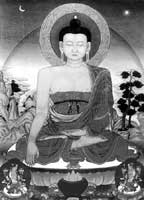|
|
||||
|
Discovering Buddha Shakyamuni’s words of wisdom |
||||
|
Three principles to reach enlightenment. In Tantra: the secret to transform energies and realise one’s own potential Buddhism - or Dharma - is a system of teachings based upon the preaching of Siddhartha Gotama, an Indian prince of the Shakya Dynasty, who renounced the privileges of his kingdom in order to dedicate himself to spiritual quest, by practising meditation in the Virgin forests of India. The three fundamental principles that lead him to enlightenment (Mahabodhi) were: Nisharana, that is renouncing worldly pleasures and the suffering of cyclic existence (samsara); Bodhichitta, that is full inner equanimity, devoid of any selfishness, when one takes the responsibility to free every being from suffering; the vision of Shuniyata, which is represented by the recognition of the true nature of all phenomena, of absolute reality. Buddha Shakyamuni taught in a most eclectic and open manner, focused that is upon reawakening the potential for enlightenment by any means, without distinctions of race or cast. For this reason, one may find apparently contradictory instructions in the translation of his orations (sutra), as well as a wide variety of approaches to inner reawakening. Each one received instructions which took his or her potential into consideration, and who was then invited to analyse these and verify their authenticity without accepting them at face value as some revealed truth. Finding a similar variety in the set of Buddha’s teachings, his followers have no difficulty in recognising the usefulness of the various existing spiritual doctrines in the world, and they understand its value in relation to the variegated predispositions of different people of as many different historical and cultural backgrounds. We note in the story of buddhism, that there is a substantial absence of religious wars and the inexistence of any missions to convert other people, seeing that one’s own path is fully respected as a valid instrument for self-betterment. However, due to numerable persecutions generated as a result of the rise to power of totalitarian regimes, Buddhism which, until the beginning of this century was the most followed, is now the third after Christianism and Islam. Buddhism has however spread in the West, where many study centres - mainly of the Zen and Tibetan tradition - work successfully. In order to familiarise oneself with the various buddhist traditions one can - as a reading key - identify two different currents, both deriving from the original teaching of Buddha. In the Theravadan tradition (or Hinayana, which means small vehicle) the spiritual objective is to reach individual liberation (pratimoksha), based upon the practice of a pure ethical discipline, the development of perfect meditative concentration and the wisdom to recognise the illusory nature of the self. The Theravadan practice has spread mostly in south-east Asia and we find it mainly in Thailand, Laos, Shri Lanka and Burma. In Mahayana (the great vehicle), the objective is no longer mere individual liberation, but rather that of the liberation of all sentient beings (those beings with the ability to experience pleasure and pain). This path of universal responsibility is called the Bodhisattva’s Path: he who, based upon love and unlimited compassion, has generated the bodhisattva motivation which consists in taking personal responsibility in liberating all beings from suffering and guide them to enlightenment. The path does in this case also pass through the three mental trainings of morality (shila), perfect concentration (samadhi) and wisdom (prajna); however, it does not end with Nirvana, the personal liberation which in the Theravadan tradition is also known as cessation of rebirth; but rather one chooses to continue to manifest oneself in the realm of cyclic existence in order to help all beings and promote their spiritual evolution. It is said that Buddha reached enlightenment in a preceeding era, manifesting 2500 years later to show the way to beings of this historical period. The practice of the various classes of Tantra is the basis of Mahayana buddhism, that is an esoterical class of teachings containing multiple techniques for energetic transformation, for the quick realisation of one’s own positive potential to dedicate one’s actions to benefitting others more efficiently and completely. Among these techniques, we find the visualisation of sacred syllables and colours, the use of sounds and sacred gestures (mudras), as well as the recitation of sacred syllables (mantra). In a therapeutic context there is the practice of NgalSo Tantric Self-Healing based upon the above mentioned techniques and developed by the Tibetan Lama Healer T.Y.S. Lama Gangchen, who places particular attention to inner and outer environmental problems with the wish to keep the Dharma relevant and up to date with the needs of our modern times. Francesco Prevosti |
||||
|
|
||||


